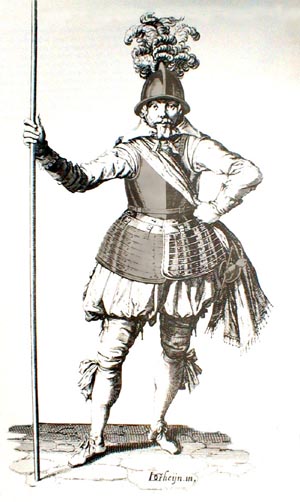In 1607 when the Jamestown Colony was established, England and other European powers were contesting over lands in the new world. The actual placement of Jamestown itself was much influenced by fear of attack by other Europeans. In the early years colonists made requests to England for more armor and they regularly inventoried arms and armor that existed at each settlement.
A gentleman may have arrived with a full suit of armor. However, the basic armor of the infantryman in early-17th-century England and Europe was the so-called pikeman’s suit. It consisted of a helmet, a breastplate, a backplate, and two tassets, or metal skirts, to protect the thighs.
The pikeman’s suit in this illustration is similar to the suits of armor brought by the Virginia Company for use at Jamestown. The specific style of many armor pieces recovered from Virginia archaeological sites would have been considered old fashioned and out of date in England at the time. Check out the helmet, the small strap holding the breastplate, the breastplate, the tasset, and the sword.
The pikeman image as well as the Musketeer image map are from engravings by Jacob de Gheyn, first published in 1607 as a military
manual entitled The Exercise of Armes.
To learn more about specific items shown in the Pikeman illustration, see these links: sword, lames, breast plates, helmet, armor strap
If you have questions or information about comparable artifacts from Virginia collections please contact Laura Galke, Chief Curator, State Archaeology Division or by phone at (804) 482-6441


